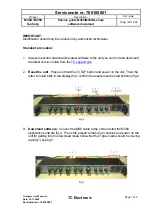Programming Model
MSC8144E Reference Manual, Rev. 3
Freescale Semiconductor
2-9
Offset Registers (N[0–3]). The 32-bit read/write offset registers N[0–3] contain offset
values to increment or decrement address registers in address register update calculations.
These registers are also used for 32-bit general-purpose storage. For example, the contents
of an offset register specify the offset into a table or the base of the table for indexed
addressing. An offset register can be used to step through a table at a specified rate—such
as five locations per step for waveform generation. Each address register can be used with
each offset register. For example, R0 can be used with N0, N1, N2, or N3 for offset
address calculation.
Base Address Registers (B[0–7]). The 32-bit read/write base address registers B[0–7] are
used in modulo calculations. Each B register is associated with an R register (B0 with R0,
and so on). When the modulo addressing mode is activated, the B register contains the
lower boundary value of the modulo buffer. The upper boundary of the modulo buffer is
calculated by B+M-1, where M is the modifier register associated with the register used.
When not used for modulo accessing, these registers can function as alternative address
registers (R[8–15]). Both Rx and B
X-8
share the same physical register. For example, if R0
is not programmed for modulo addressing, the base address register B0 can serve as an
additional address register R8.
Modifier Registers (M[0–3]). The 32-bit read/write modifier registers M[0–3] contain the
value of the modulus modifier. These registers are also used for general-purpose storage.
The address arithmetic unit (AAU) supports linear, modulo, multiple wrap-around
modulo, and reverse-carry arithmetic types for most address register indirect addressing
modes. When the modulo arithmetic is activated, the contents of Mj specify the modulus.
Each address register can be used with each modifier register, as programmed in the
MCTL register.
Modifier Control Register (MCTL). The 32-bit read/write register to program the address
mode (AM) for each of the eight address registers (R[0–7]). The addressing mode of the
upper address register file (R[8–15]) cannot be programmed and functions in linear mode
only.
Summary of Contents for MSC8144E
Page 1: ...MSC8144E Reference Manual Quad Core Media Signal Processor MSC8144ERM Rev 3 July 2009 ...
Page 48: ...MSC8144E Reference Manual Rev 3 xlviii Freescale Semiconductor ...
Page 86: ...MSC8144E Reference Manual Rev 3 1 38 Freescale Semiconductor Overview ...
Page 168: ...MSC8144E Reference Manual Rev 3 3 60 Freescale Semiconductor External Signals ...
Page 242: ...MSC8144E Reference Manual Rev 3 5 26 Freescale Semiconductor Reset ...
Page 314: ...MSC8144E Reference Manual Rev 3 8 24 Freescale Semiconductor General Configuration Registers ...
Page 414: ...MSC8144E Reference Manual Rev 3 10 14 Freescale Semiconductor MSC8144E SC3400 DSP Subsystem ...
Page 452: ...MSC8144E Reference Manual Rev 3 11 38 Freescale Semiconductor Internal Memory Subsystem ...
Page 520: ...MSC8144E Reference Manual Rev 3 12 68 Freescale Semiconductor DDR SDRAM Memory Controller ...
Page 1070: ...MSC8144E Reference Manual Rev 3 21 28 Freescale Semiconductor Timers ...


















